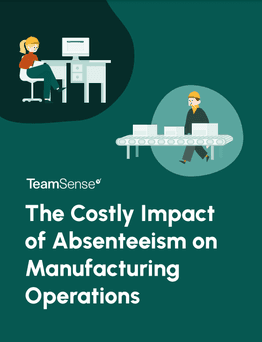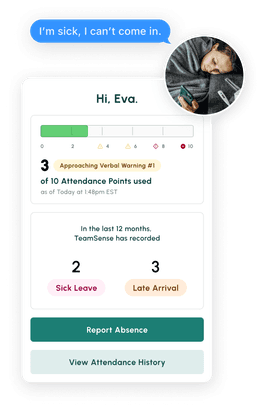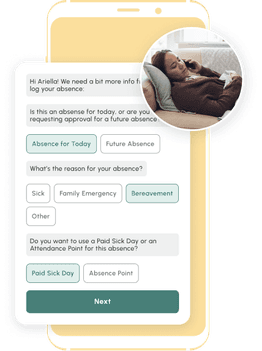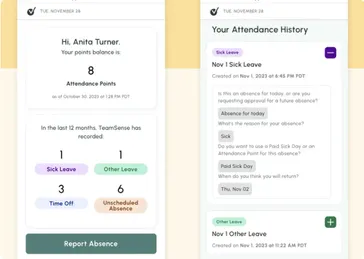When to HR with AI (and When Not To)!
Table of Contents
- What Is an Attendance Point System?
- How Does an Attendance Point System Work?
- Legal Considerations of Attendance Point Systems
- Attendance Point System Examples
When Do Attendance Points Reset?- How to Create an Attendance Policy Based on A Point System
- What Are the Benefits of an Attendance Point System?
- What Are the Cons of an Employee Attendance Point System?
Between rewards cards, sports games, and loyalty programs, it's safe to say most people like their points systems. There's just something about seeing hard work pay off by watching scores go up and up. But all that changes when it comes to attendance point systems for employees. While loyalty points at your local coffee joint get you closer to a free cup of java, attendance points get you closer to disciplinary action. And just like decaf coffee–nobody wants that.
To keep a productive hourly workforce running, employees must show up on time and be ready to work their scheduled shifts. Having an attendance point system can help employees keep absences in check.
What Is an Attendance Point System?
An employee attendance point system is like the opposite of your favorite loyalty rewards program. Instead of getting closer to free coffee with every point, you’re inching toward disciplinary action. Ouch. But when it comes to managing a productive hourly workforce, keeping track of absences is crucial. Attendance point systems give companies a clear, measurable way to handle no-shows and tardiness while rewarding stellar attendance.
But how did this system come to be, and why do so many companies swear by it? Let’s dive into a quick history lesson and see why attendance tracking and point systems are the MVPs of absence management.
A Brief History of Attendance Point Systems
Tracking attendance isn’t exactly new—it’s been a thing since the Industrial Revolution. Back then, factories needed to keep production lines moving, so they used timecards and punch clocks to monitor who showed up on time. Over the years, these methods evolved into more advanced systems, thanks to the magic of digital tech.
Fast forward to the late 20th century, and companies started rolling out point systems to standardize how they handled tardiness and absences. The beauty of these systems? They’re easy to understand, fair (when done right), and give managers a clear-cut way to enforce attendance policies. No more guesswork or playing favorites—just consistent rules across the board.
Industries Where Attendance Point Systems Shine
Some industries rely on their attendance records and point systems more than others. Why? Because one person’s absence can throw the whole operation out of whack. Here are a few fields where these systems work like a charm:
- Manufacturing: When one worker doesn’t show up, production schedules can go haywire. Attendance systems help keep things running smoothly.
- Healthcare: Patients need care 24/7, so reliable staffing isn’t just important—it’s critical.
- Retail and Hospitality: Nobody wants to wait in endless lines or deal with short-staffed restaurants. Attendance systems ensure businesses can meet customer expectations.
- Logistics and Warehousing: Late shipments and disrupted supply chains are a no-go. These industries need staff to show up on time, every time.
While hourly and shift-based roles benefit the most, even office settings can use attendance systems to keep everyone on track.
TL;DR Summary
Attendance point systems help companies manage absences and tardiness by assigning points for infractions. Unlike loyalty programs, more points mean disciplinary actions, not rewards. These systems ensure fairness and consistency, especially in industries like manufacturing, healthcare, retail, and logistics, where reliability is critical.
How It Works:
Employees earn points for being late or absent, which escalate toward warnings, probation, or termination. Example: 10 points = verbal warning; 30 points = potential termination. Companies may reset points after a period of perfect attendance to encourage behavior change.
Legal Considerations:
Protected absences (FMLA, ADA, state laws) must not accrue points. Clear policies, documentation, and manager training are essential to avoid lawsuits, fines, or reputation damage.
Benefits:
Attendance systems reduce absenteeism, improve productivity, and provide clear expectations. Gamifying attendance with rewards (e.g., extra PTO or gift cards for perfect attendance) can boost morale.
Challenges:
Exceptions for emergencies can cause confusion, and employees may feel micromanaged. Open communication and transparency help ease these concerns.
TeamSense: Empowering Employees with Transparency
One of the biggest frustrations employees face with attendance point systems is the lack of clarity. TeamSense eliminates this problem by giving employees real-time visibility into their attendance points before they call off. This transparency helps employees make informed decisions, reduces confusion, and builds trust between employees and employers.
By empowering employees with easy access to their attendance records, TeamSense turns a potentially stressful system into one that fosters accountability and fairness.
How Does an Attendance Point System Work?
Like we said earlier, the more points you have to your name, the worse things are. When employees are late or absent, they accumulate points. Basically, the total number of points an employee has will determine if they receive a written warning only, are put on probation, or are at risk of termination. The stakes get higher and higher as the attendance points add up.
For example, if an hourly worker piles up 10 points within one calendar year, then they get a verbal warning. When they hit point threshold of 20 points, they receive another verbal warning and a written warning that goes in their employee file. At 30 points, hourly employees are at risk of being fired.
So, how do team members avoid adding points to their name? Simple. By making sure their absences or late arrivals are few and far between and cleared with their managers in advance.
Legal Considerations of Attendance Point Systems
Implementing an attendance point system sounds like a dream for keeping absenteeism in check, but it’s not as simple as handing out points like candy. There are legal implications you need to consider to keep your company out of hot water. Let’s break it down.
Protected Absences
Not all absences should result in attendance points. In fact, assigning points for certain types of absences can land you in serious legal trouble. Here are some examples of absences that may be protected by law:
- Family and Medical Leave Act (FMLA): Employees are entitled to unpaid, job-protected leave for qualified medical and family reasons. Docking points for FMLA-approved absences is a big no-no.
- Americans with Disabilities Act (ADA): Reasonable accommodations, including time off for medical appointments or recovery, must be provided to employees with disabilities.
- State-Specific Leave Laws: Many states have additional leave laws covering everything from sick leave to bereavement. Make sure your policy aligns with local requirements.
Crafting Policies That Align with Labor Laws
Creating an attendance point system isn’t just about tracking attendance trends and tardiness; it’s about doing it right. Here’s how to stay compliant:
- Define Protected Absences Clearly: Include a section in your attendance policy outlining which absences are protected and exempt from point accrual.
- Standardize Documentation: Use a consistent process for employees to report absences, such as requiring FMLA paperwork or a doctor’s note when applicable.
- Train Managers: Ensure your leadership team understands labor laws and knows how to handle exceptions fairly.
- Review Policies Regularly: Laws change, so make it a habit to review and update your attendance policy annually to stay compliant.
Potential Pitfalls of Non-Compliance
Ignoring legal considerations can lead to:
- Employee Lawsuits: An employee penalized for a protected absence could file a claim against your company, resulting in costly legal fees and damages.
- Government Fines: Failure to comply with federal or state labor laws can lead to audits and hefty fines.
- Reputation Damage: Legal troubles can tarnish your company’s reputation, making it harder to attract and retain talent.
By addressing these legal considerations upfront, you’ll not only protect your company but also create a fairer, more transparent attendance policy that works for everyone.

The Costly Impact of Absenteeism on Manufacturing Operations
Learn how chronic, unplanned absenteeism is a costly impediment to manufacturing productivity and efficiency, and how you can reduce absenteeism.
Attendance Point System Examples
If a company has a disciplinary point system for employees, they probably have all the ins and outs of how their points stack up in the attendance policy. And although each company might have its own point system for employees, some companies follow the same point system for attendance issues all locations.
If you're making your own attendance point system from scratch, here is an example you can follow:
Employee Point System Example
Time | Point(s) | Reason |
> 15 minutes late | 1 | Tardy |
15 minutes-2 hours | 3 | Late |
< 2 hours or no show | 5-10 | Unauthorized absence |
When Do Attendance Points Reset?
Ah, yes, the big question most team members want answered is how long do they have to wait until their attendance points go back to zero. And it's a great question! If your company is following attendance policy as a corporate mandate, then your attendance point system policy or employee handbook should clearly state this information.
If your company is smaller and you get to call the shots, a good rule of thumb here is to let good employees have the points reset after two months of perfect attendance on consecutive days. You want to see that a behavior change has happened here. Be sure to include the reset plan for attendance points in your employee attendance improvement plan as well.
How Employees View Attendance Point Systems
It’s no secret that attendance point systems can feel like a double-edged sword for employees. On one hand, they create structure and transparency; on the other, they can spark anxiety and frustration. Let’s explore some common employee concerns and how companies can address them to build trust and employee morale and reduce stress.
Common Employee Concerns
- Fear of Unfair Penalties: Employees worry about being penalized for circumstances beyond their control, like car trouble, childcare emergencies, or unexpected illness.
- Lack of Clarity: Confusion about how points are assigned or when they reset can lead to frustration and feelings of being blindsided.
- Perception of Micromanagement: Point systems can feel overly strict, especially if employees believe they’re being monitored too closely.
Building Trust Through Communication
- Explain the "Why": Start by helping employees understand why the attendance point system exists. Emphasize that it’s not about punishing them but about creating fairness and maintaining productivity.
- Be Transparent: Clearly outline how points are assigned, how resets work, and what steps employees can take to avoid penalties. Provide this information in writing and during onboarding.
- Offer Flexibility Where Possible: Show employees you’re willing to work with them by accommodating legitimate issues, like allowing remote work or shift swaps when feasible.
- Highlight the Positives: Don’t let the system be all about discipline. Celebrate employees with perfect attendance through rewards or public recognition to keep morale high.
Making Employees Part of the Process
One way to ease employee concerns is by involving them in the development or refinement of the attendance policy. Conduct surveys, gather feedback, and show employees that their voices matter. When employees feel heard, they’re more likely to view the system as fair and less like a disciplinary hammer.
By addressing employee concerns head-on and fostering open communication, attendance point systems can become a tool for teamwork and accountability rather than a source of tension.

How to Create an Attendance Policy Based on A Point System
The size of your workforce, your absenteeism rates, attendance patterns, and the number of people who manage absences will influence your approach to your point system. Here are a few steps to get you started:
- Decide how you will track points, from a simple DIY spreadsheet template to integrating point tracking into your absence management software or time clock system.
- Implement an employee call-out system with standardized questions to make sure absences are properly coded (so the correct points can be applied or not applied).
- Think about the disciplinary actions and rewards that will motivate your workforce.
- Add the points system to your attendance policy as a section or an amendment. (Don't have an employee attendance policy? Then now is the time to create one!)
- Have new hires read and sign the point system policy during employee onboarding.
- Make the employee point system easily available to all employees for future reference in your company's ESS portal.
- Be sure that your entire workforce has visibility to their points, so they are always aware of where they stand.
- Celebrate achievement as they earn rewards with team-wide recognition.
Remember that the success of your points system depends on team members understanding it and feeling motivated by it. Transparency and communication are essential to helping this system thrive.
What Are the Benefits of an Attendance Point System?
An employee point system can boost attendance numbers and help keep your hourly team on track when well thought out and done correctly. Let's dig into the pros of attendance point systems a little more.
Point systems are easy to understand.
Attendance point systems are pretty easy to figure out—making them ideal for managing a large team. Because they're simple, there's not a huge burden on the employer or the employee either. Knowing how many points it takes before disciplinary action hits means no team member should be in the dark. Having a work point system at your company gives your team concrete rules to work within.
It improves engagement.
Think about it this way: When your employees know they're getting too close for comfort to that disciplinary line, they'll probably be more likely to stay engaged and make an effort to come into work (fingers crossed. But if there isn't a clear absence or late arrival policy at a company, it's pretty easy for employees to get a little too relaxed with their clock-in times.
A work point system offers fair and equal treatment.
Need to make sure there's no special treatment or favoritism happening at your company? Good news! A solid attendance point system coupled with a clear attendance policy will have your back. When everything is laid out clearly, the management team is held accountable to follow through with the same kind of treatment for everyone.
An attendance point system lets employees know where they stand.
A point system can help employees visualize just how close they are to getting a formal warning (or worse) and help encourage them to make a change. If this kind of information is kept hidden from your team, it's a lot harder for them to know how to change. With an attendance point system policy like this, everything is straightforward for your team with attendance expectations and no gray area on what's expected.
It makes rewarding good attendance easy.
Sure, avoiding being on the receiving end of a write up is motivating, but rewards can also influence positive attendance behaviors from your team too. Instead of having your team associate attendance point systems with negatives only—use it for good! You can reward employees who have few or no points and celebrate when they hit a milestone like perfect attendance for the month. Six months with no points? They can earn a gift card or a free lunch. A whole calendar year with no points? They earn an extra paid day off. The options are endless! This is a great way to encourage employees on your team to come to work and make good attendance a priority.
Disciplinary point systems reduce absences.
This one might be a no-brainer, but it's still true. When team members know that every unexcused absence and late arrival adds up against them, they'll probably make more of an effort to show up. Attendance points have a way of taking the idea of showing up to work and making it something folks can gamify. Who isn't motivated by tangible things like rewards and toeing the line to not get written up? It works.

No one wants to talk to their boss or a 1-800 stranger to call off. Text changes everything - Reducing No Call No Shows.
What Are the Cons of an Employee Attendance Point System?
You know the old saying, there are two sides to every story? Well, that's true with attendance point systems too. Some companies might find that having an employee point system makes life easier; other companies might discover that it just doesn't work for them.
Absences can be nuanced.
Sometimes things aren't as black and white as just dishing out an attendance point for an unplanned absence though. You might find that there's more to the story. Did a transit strike cause the delay? Was there some kind of circumstance out of the team member's control that caused the absence? This brings up bigger questions you'll have to ask yourself, like: Should we make exceptions? And if so, where do we draw the line?
Exceptions can lead to confusion.
While you can definitely make exceptions (and might need to from time to time), there's no denying that exceptions can make things confusing. Exceptions need to be taken into consideration when outlining your points system, but exceptions can make things even more complicated.
Can an Attendance Point System Fix Absenteeism?
Yes! All in all, an employee point system is an effective way to reduce absenteeism, improve attendance rates, and encourage on-time clock-ins.
One study saw a 47% decrease in absenteeism when a grocery store started using an employee points reward system.1 Which isn't too surprising, right? People like a challenge and having something to work toward. So, remember to use your points system to positively influence your hourly team members—not just as a scare tactic to get them to show up for work.
If you really want to help make unexcused absences a thing of the past for your team, make it easier on them to let you know they'll be out. The best way to do that? Get an attendance management system that lets your team text their status for the day. That's right, we said text. It really is that simple to transform communication within your team.
About the Author

Jackie Jones, Employee Engagement & Attendance Specialist
Jackie Jones has over three years of experience helping HR teams improve employee morale, reduce absenteeism, and create happier, more engaged workplaces. With a strong background in employee relations and attendance management, she brings practical strategies and insights that support frontline teams and the HR professionals who lead them.

